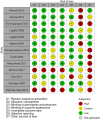Pharmacological Interventions for Sialorrhoea in People with Parkinson's Disease: A Systematic Review and Meta-Analysis
- PMID: 37070045
- PMCID: PMC10105093
- DOI: 10.1002/mdc3.13688
Pharmacological Interventions for Sialorrhoea in People with Parkinson's Disease: A Systematic Review and Meta-Analysis
Abstract
Background/objectives: Sialorrhoea is a common non motor complication experienced by people with Parkinson's disease (PD). Despite its prevalence there is conflicting evidence on how to effectively treat it. Our aim was to establish the efficacy and safety outcomes of pharmacological interventions used to treat sialorrhoea in people with idiopathic PD.
Methods: We registered and conducted a systematic review and meta-analysis (PROSPERO: CRD42016042470). We searched seven electronic databases from inception until July 2022. Quantitative synthesis was performed where data allowed using random effects models.
Results: From 1374 records we included 13 studies (n = 405 participants). Studies were conducted in Europe, North America and China. There was marked heterogeneity in the interventions used, follow up times and outcome measures investigated. The main source of risk of bias identified was reporting bias. Five studies were included in the quantitative synthesis. Summary estimates showed administration of botulinum toxin significantly reduced saliva production, improved patient reported functional outcomes and was associated with an increase in adverse events.
Conclusion: Sialorrhoea in PD is an important condition, but current data does not allow for strong recommendations on optimal pharmacological treatments. There is significant heterogeneity in outcomes measures used to evaluate the burden of sialorrhoea with lack of consensus on what constitutes clinically meaningful change. More research is required to better understand the underlying mechanism and potential treatments of sialorrhoea in idiopathic PD.
Keywords: Parkinson's disease; botulinum toxin; sialorrhoea.
© 2023 International Parkinson and Movement Disorder Society.
Figures



References
-
- Chou KL, Evatt M, Hinson V, Kompoliti K. Sialorrhea in Parkinson ’ s Disease: a review. Mov Disord 2007;22(16):2306–2313. - PubMed
-
- Kalf JG, Scholten S, Hopman W. Saliva swallowing frequency measured using 24‐hours ambulatory impedance‐pH monitoring in patients with Parkinson's disease and drooling. Mov Disord 2016;31(suppl 2):S279. http://ovidsp.ovid.com/ovidweb.cgi?T=JS&PAGE=reference&D=emed17&NEWS=N&A....
-
- Proulx M, de Courval FP, Wiseman MA, Panisset M. Salivary production in Parkinson's disease. Mov Disord 2005;20(2):204–207. - PubMed
Publication types
LinkOut - more resources
Full Text Sources

